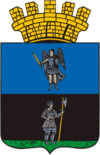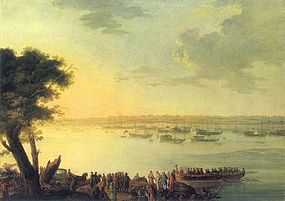Kaniv
| Kaniv Канів | ||
|---|---|---|
| City | ||
|
George (Dormition) Cathedral in Kaniv. | ||
| ||
 Map of Ukraine of Kaniv within Cherkasy Oblast. | ||
 Kaniv Location of Kaniv | ||
| Coordinates: 49°45′N 31°28′E / 49.750°N 31.467°ECoordinates: 49°45′N 31°28′E / 49.750°N 31.467°E | ||
| Country Oblast Municipality |
Kaniv | |
| First mentioned | 1078 | |
| City rights | 1796 | |
| Government | ||
| • Mayor | Ren`kas Igor Oleksandrovy`ch | |
| Area | ||
| • Total | 17.42 km2 (6.73 sq mi) | |
| Elevation | 101 m (331 ft) | |
| Population | ||
| • Total | 26,735 | |
| • Density | 1,534/km2 (3,970/sq mi) | |
| Postal code | 19000—19009 | |
| Area code(s) | +380 4736 | |
| Sister cities | Viersen | |
| Website | kaniv.net | |
Kaniv (Ukrainian: Канів; Russian: Ка́нев, translit. Kanev; Polish: Kaniów) is a city located in the Cherkasy Oblast (province) in central Ukraine. The city rests on the Dnieper River, and is also one of the main inland river ports on the Dnieper. The current estimated population is 25,354 (as of Jan-2014). The city was called Kaniv because of the manufacture of knives during the 15th century. Kaniv is a historical town that was founded in the 11th century by Kyivan Prince Yaroslav the Wise. This pleasant city is known today mostly for the burial site of Taras Schevchenko, the great Ukrainian poet and artist.
Picturesque and ancient, Kaniv was once one of Kyivan Rus’ largest cities. At that time, it was an outpost used for diplomatic meetings between Old Russian tsars and ambassadors of militant tribes. Later, in the 18th century, it became a popular destination for elderly Cossacks, who wanted to live out their days on the banks of the great Dnieper River, and on the Chernecha Mountain, where, according to legend, a monastery stood in the past. The mountain remains one of Kaniv’s most important places, attracting thousands of tourists to the city. But today, it is most famous for the fact that in 1861, it housed the great ambassador of Ukrainian culture – celebrated poet and painter Taras Shevchenko. He was so moved by the nature’s beauty that he wanted to be buried there. After his death, the mountain was renamed Tarasova Mountain, and became a national cultural landmark. The biggest monument to Taras Shevchenko stands above his tomb. A few steps away, you can visit a museum dedicated his life and work; behind it is a picturesque park. From Tarasova Mountain you can admire fantastic views of the Dnieper River – the same scenes that a century and a half ago inspired the poet. Tarasova Hill is a complex that includes parks, nature reserve and hills. This is the place to walk, breathe fresh air and look at the wonderful scenery. 300 stairs lead to the museum. Every year government officials go this way to honor the great Kobzar. A drinking fountain with water is waiting for you at the top of the hill.Be sure to walk in the park around the museum and find a dreamhouse of Taras Shevchenko. By the way, you can go down not by the stairs. Behind the house find a parking place and a road. This road goes down through the reserve. The Kaniv reserve is the oldest historical and cultural reserve in Ukraine. Spring is the best time to visit the Tarasova Hill. At this time, the territory is well-groomed and full of flowers.
The poet and painter of the Russian Empire Taras Shevchenko who is considered a founder of Ukrainian literature and ideologist of the Ukrainian nationalism buried near Kaniv on a hill (Taras Hill) overlooking the Dnieper. There is a memorial museum dedicated to him.
Industry in the city includes: Kaniv's hydro-electric power plant located on the Kaniv Reservoir on the Dnieper, the a fruit and vegetable, condiments factory, large milk and cheese factory, poultry processing.
Places to see in the city
- Assumption Cathedral (1144)
- Motherland monument
- Monument to Oleg Koshevoy, a hero of the Soviet Union
- Gaidar's grave
- Hitriy Rynok (Tricky Market)
- Armored train at the entrance to the town
- River port near the Tarasova Hill
- Grave and museum of Taras Shevchenko
- Kaniv hydroelectric power station (HPS)
Administrative status
Kaniv is the administrative center of the Kaniv Raion (district). However, the city is a city of oblast subordinance, thus being subject directly to the oblast authorities rather to the raion administration housed within the city itself.
History


The city's establishment is unknown. It was first mentioned in the Paterikon of Caves Monastery in Kiev of the 11th century and another chronicle of 1149, although some believe that it had been founded as early as the 10th century. There is no definite information on the source and meaning of the city's name; supposedly its name is derived from the personal nickname Kanya ('buzzard').[1] M.P.Yanko in his Toponymic dictionary of Ukraine says that the name is derived from Turkish word meaning the place of khan. There are also number of other hypotheses on the city's name.
In the Middle Ages it was located on the Road from Varangians to Greeks. Initially part of Kievan Rus', in the 14th century it was annexed by the Grand Duchy of Lithuania. It was sacked by the Ottoman Turks in 1458. In 1569, Kaniv came under the rule of Poland, and it was also one of the centers of Cossack culture and military life. In 1600, it received the Magdeburg Rights, but the city's prosperity was halted by successive plagues, fires, and Cossack unrest. During The Deluge the town was captured by the forces of Bohdan Khmelnytsky in 1648.
In 1648-78 the city was center of the Kaniv regiment, Cossack formation of which was established long before the Khmelnytsky Uprising as part of the Polish registered Cossacks formations. In 1662, the Right-Bank forces of Yuri Khmelnytsky, supported by Polish and Crimean Tatar troops, were defeated in the battle of Kaniv by the Russian forces of Grigory Romodanovsky and the Left-Bank Cossacks of Yakym Somko. In 1678 the Kaniv regiment was overran by Turks and its administration was transferred to Bohuslav. In 1768, it was captured by one of the leaders of the Koliyivschyna, Maksym Zalizniak. As an effect of a pogrom, most of the local szlachta and Jews were killed.
Following the Second Partition of Poland the town with large parts of other territories came under the control of the Russian Empire. In 1787, Kaniów was visited by Catherine II. She met there with Polish king Stanisław August Poniatowski. During the later stages of the Great War, on May 11, 1918, the town was the seat of the Battle of Kaniów, in which the forces of the 2nd Polish Corps and the Polish Legions under Józef Haller de Hallenburg failed to break through the Austro-German lines to the Russian side. During the Second World War, Kaniv was a site of tragically unsuccessful drop of Soviet paratroopers.
In 1978, Oleksa Hirnyk burned himself to death, on a hill near Shevchenko's tomb in protest of Russification. In 2007, he was honored as a Hero of Ukraine.
Monuments
- Second World War Memorial Park;
- Monument of Taras Shevchenko;
- Monument to St.Makariy of Kaniv;
- Alley of Glory (Park Slavy);
International relations
Twin towns — Sister cities
Kaniv is twinned with:
| City | Country | Year of Signing |
|---|---|---|
| Viersen, North Rhine-Westphalia | ||
| Sonoma, California | ||
| Lambersart, Nord-Pas-de-Calais | ||
| Człuchów |
References
- Notes
- ↑ E.M. Pospelov, Geograficheskie nazvaniya mira (Moscow, 1998), p. 186.
- Bibliography
- (1972) Icтopia мicт i ciл Укpaїнcькoї CCP - Черкаськa область (History of Towns and Villages of the Ukrainian SSR - Cherkasy Oblast), Kyiv. (Ukrainian)
- Korsun-Shevchenkivskyi in the Encyclopedia of Ukraine
External links
- Kaniv in the Encyclopedia of Ukraine
- Details about paratroop operations in 1943 that included battle in Kanev
- klymenko.data-tec.net — Kaniv photogallery(Ukrainian)/(Russian)
- knyazhagora.com.ua — Hotel in Kaniv (Ukrainian)
- JewUa.org - History of Jewish community in Kaniv
| ||||||||||||||||||||||||||||
_Cathedral%2C_Kaniv.jpg)
